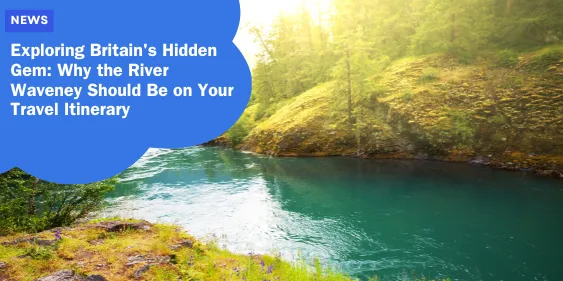Exploring Britain’s Hidden Gem: Why the River Waveney Should Be on Your Travel Itinerary

The River Waveney, stretching 59 miles along the border of Norfolk and Suffolk, offers a secluded sanctuary of natural beauty and historical depth.
Despite being highlighted in Roger Deakin’s influential work, “Waterlog,” which spurred the wild swimming movement in Britain, many people remain unaware of this scenic treasure.
Originating at Redgrave and Lopham Fen, the Waveney gracefully winds through East Anglia, eventually merging with the River Yare before flowing into the sea at Great Yarmouth.
Its banks are teeming with diverse wildlife, including otters, kingfishers, and water voles.
Deakin’s account in “Waterlog” has immortalized the Waveney, making it a cherished destination for wild swimming enthusiasts.
His vivid descriptions of canoeing adventures and the river’s serene landscapes highlight the Waveney as an enchanting escape into the untouched wilderness of East Anglia.
The river’s willow-fringed bends and hidden pools offer a slow-paced, romantic retreat for those yearning to reconnect with nature.
The Waveney’s Historical Significance
Role in Britain’s Wild Swimming Movement
The River Waveney plays a pivotal role in the history of Britain’s wild swimming movement, largely due to Roger Deakin’s seminal book, “Waterlog.”
Deakin’s affection for the Waveney was evident as he portrayed it as a “gateway” to an alternate realm. His frequent swims in the river not only inspired “Waterlog” but also advocated for the right to enjoy natural waters.
Historic Drainage Mills and Their Importance
A defining feature of the Waveney’s landscape is its historic drainage mills, which once were instrumental in draining marshlands to make the land more suitable for agriculture.
These mills, some of which still stand, are relics of the past. Although some have fallen into disrepair, others remain as iconic symbols, especially striking amidst the winter mist.
Rich Wildlife Habitat
The Waveney is a sanctuary for various species. Otters can frequently be seen basking on floating logs, while kingfishers flash their brilliant blue feathers across the water.
Water voles, rare in many parts of the UK, find a haven along the riverbanks.
Deakin’s encounters with this abundant wildlife only deepened his reverence for the Waveney, making it a central theme in his writings and broadcasts.
Ongoing conservation efforts aim to protect these habitats, ensuring future generations can experience the same vibrant ecosystem.
Natural Beauty and Seasonal Changes
Scenic Landscapes Throughout the Year
The River Waveney presents a picturesque journey through East Anglia, with its beauty evolving with each season.
Winter casts an almost mystical spell over the river, as frost stiffens the reeds and the mills rise like spectral sentinels.
Spring brings a vibrant awakening, with pussy willow seeds drifting on the water like delicate snowflakes.
Summer offers lively bird chatter and blooming hedges, while autumn envelops the landscape in warm hues and tranquil reflections.
Unique Features: Secret Pools and Sandy Beaches
The Waveney is adorned with unique features that invite exploration. Hidden pools and sandy beaches line its course, providing serene spots for a refreshing swim or a peaceful picnic.
These natural gems are lovingly described in Deakin’s “Waterlog,” where he refers to the river as his gateway to another world.
Diverse Flora and Fauna Along the River
The riverbanks are home to a diverse array of flora and fauna. Otters dart in and out of the water, kingfishers dive for fish, and water voles scurry along the banks.
The ecosystem supports a variety of plant and bird species, creating a haven for wildlife enthusiasts.
Each season brings a new palette of colors and experiences, making the Waveney a captivating destination whether you’re cycling its gentle curves or strolling its serene banks.
Exploring the Waveney: Activities and Attractions
Cycling and Walking Routes
The River Waveney offers an ideal setting for cycling and walking.
The landscape remains largely undeveloped, allowing for uninterrupted enjoyment alongside the river.
A notable cycling route spans 104 miles, starting from Diss railway station and passing through charming villages like Bungay and Beccles.
For walkers, the Angles Way provides a rewarding path that follows the river at various points, from Knettishall Heath to Great Yarmouth.
Wild Swimming and Kayaking Opportunities
Wild swimming is a key feature of the Waveney experience, with secret pools and sandy beaches inviting exploration.
Inspired by Deakin’s renowned swims, visitors can enjoy invigorating dips and encounter local wildlife.
Kayaking from Redgrave and Lopham Fen to the Geldeston Locks reveals the region’s timeless beauty and thriving wildlife, including otters and kingfishers.
Historic Sites and Charming Villages
Exploring the Waveney includes discovering its rich history.
The village of Somerleyton boasts the Herringfleet smock drainage mill, the oldest on the Broads. Bungay, steeped in the legend of the Bungay Black Dog, offers indie shops and a 12th-century castle.
The Geldeston Lock Inn, with its white weather-boarded exterior, provides a cozy atmosphere and live music, reflecting the area’s historical significance.
Cultural and Culinary Experiences
Local Craft Breweries and Indie Cafes
Exploring the River Waveney also means enjoying its local craft breweries and indie cafes.
Ampersand Brew Co. in Harleston offers inventive craft beers like Bidon pale ale and Basil Blush with raspberry.
The indie cafes of the Waveney Valley, such as Earsham Street Café in Bungay, serve delicious coffee and provide a warm, inviting atmosphere perfect for fueling your next adventure.
Historic Pubs and Inns Along the Route
Historical pubs and inns dot the River Waveney, each with its own story to tell.
The Geldeston Lock Inn is known for its live music and welcoming ambiance, ideal after a day of kayaking or cycling.
Further upstream, the Fleece Inn in Bungay offers a 16th-century charm, delectable meals, and rich local ales, making it a memorable stop on your journey.
Unique Attractions: The Bungay Black Dog Legend
No exploration of the Waveney is complete without delving into its rich lore.
The legend of the Bungay Black Dog, or Black Shuck, is particularly intriguing.
This ghostly hound is said to have haunted Bungay for centuries, with the town commemorating the legend through various nods, including the Black Dog Running Club.
Visitors can ponder this eerie legend while exploring Bungay’s indie shops and historical atmosphere.
Planning Your Waveney Adventure
Recommended Itineraries for Cycling or Walking
The River Waveney’s terrain is ideal for cycling, with its gentle undulations and scenic views.
A recommended itinerary starts at Diss railway station, covering 104 miles over four days, passing through picturesque villages like Bungay and Beccles.
For walkers, the Angles Way offers a rewarding route that aligns with the river at various points, stretching from Knettishall Heath to Great Yarmouth.
Accommodation Options and Luggage Transfer Services
Accommodation options range from quaint bed and breakfasts to cozy inns.
The Black Dog Freehouse in Bungay provides a unique historical ambiance, while The Fleece Inn offers both comfort and a glimpse into local lore.
For added convenience, consider luggage transfer services like Bikeline, which transport your belongings between accommodations.
Best Times to Visit and Safety Considerations
The Waveney offers different experiences throughout the year: sunny swims in summer, vibrant foliage in fall, and the stark beauty of frosty winters.
Late spring through early autumn is the ideal time to visit for optimal weather.
It is important to respect local wildlife, stay on designated paths, and avoid swimming in the river 48 hours after heavy rainfall to ensure safety from pollution runoff.
The Waveney’s Future and Conservation
Efforts to Preserve the River’s Natural Beauty
The River Waveney’s serene beauty and rich biodiversity have led to extensive conservation efforts.
Maintaining the river’s landscapes and historical features is a primary goal.
Organizations and volunteers work together to clean the riverbanks, plant native species, and restore habitats.
Preserving historic mills, like the Herringfleet smock drainage mill, helps retain the river’s historical charm.
Importance of Responsible Tourism
As tourism increases, responsible practices become crucial.
Visitors are encouraged to respect wildlife, adhere to designated paths, and properly dispose of waste.
Responsible tourism helps minimize human impact on delicate ecosystems and ensures the river remains pristine for future generations.
Ongoing Initiatives to Protect Wildlife and Water Quality
Ongoing conservation initiatives focus on preserving water quality and wildlife habitats.
Efforts include monitoring pollution levels, promoting organic farming practices, and improving sewage treatment to reduce harmful runoffs.
Projects supporting the river’s iconic species, like otters and kingfishers, further enhance biodiversity along the Waveney.
As we appreciate and protect the Waveney, each explorer contributes to preserving its untamed charm.
The journey along this hidden gem promises an enriching experience where history and nature harmoniously coexist.






